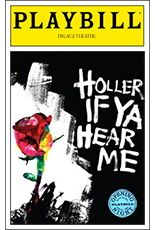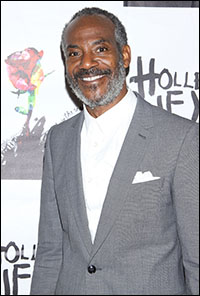
*
Either it was calculated or it was kismet that June's Broadway opening, Holler If Ya Hear Me, fell on June 19 — "June 'Teenth," the oldest known holiday commemorating the announcement of the abolition of slavery in Texas in 1865 and, more generally, the emancipation of African-American citizens throughout the United States.
Normally, Broadway directors don't feel compelled to sign in before their shows, but Kenny Leon, new Tony winner in town (for A Raisin in the Sun), took to the Palace stage and leveled with the audience. "I'm just going to be honest and truthful with you tonight," he declared. "This is opening night of a revolution of a theatre piece."
The author of the revolution was the late Tupac Shakur, the rapper-poet-actor who was murdered in the East Coast-West Coast hip-hop wars of 1996. He was only 25.
In that brief time, he managed to sell 75 million records worldwide and become one of the best-selling music artists of all time (#86 among Rolling Stone's Top 100). Here, 20 of his big hits are shoehorned into a fictional storyline that reflects his lyrics about the grim and grime of contemporary ghetto life of a midwestern city. [flipbook]
To turn the long-cherished theatrical home of Judy and Annie into a stoop for Tupac certainly requires a revolution — and got it. The legendary show place with its rococo trim has been reconfigured, at a loss of 650 seats, into an intimate, stadium-type venue that one ordinarily finds at edgy events like rock concerts and such.
After walking through the two Palace lobbies, it's startling to discover the rear orchestra empty of patrons, and a huge mural from The National Museum of Hip-Hop cutting the ground-level orchestra section in two. On the other side of the mural, Rows A through J climb from the edge of the stage up to the front mezzanine.
This mural, by graffiti artist Andre Trenier, employs the four elements of hip-hop, which — I'm sure I don't have to tell you — are DJing, MCing, B-Boying and Graffiti. NMoH (that's The National Museum of Hip-Hop) also decorated the Palace walls with a Hip-HopExhibition featuring memorabilia unique to the genre and, on both sides of the empty orchestra seats, Dream Walls, where patrons become graffiti artists and scrawl their dreams. My favorite: "I'm dreaming of a Best Sound Tony."

Buy this Limited Collector's Edition |
"It's a very emotional show," one of the more high-voltage bros in the hood, Dyllon Burnside, was pleased to admit. "Going through that journey every night is difficult, but it's also so much fun. The energy up there on that stage is electrifying.
"I think the seating definitely helps. You know, when we're up — especially during 'Holler If Ya Hear Me,' which is our end of Act I number — we are literally performing, rapping, singing — directly at the audience there in the audience seating, so we see the people singing the song with us, we see their reactions, we see the ones who are taken aback, we see the people who are cheering us on.
"I don't know who thought of that seating idea, but Kenny has been really adamant about us using that to our best ability and making sure our sightlines are up."
Eric L. Gold, the Hollywood super-agent who conceived the show and became its prime mover and lead producer, originally contacted a fellow Pittsburgh native about writing the book for the musical. Sadly, August Wilson was entering his final homestretch with two more plays to write to complete his 10-play cycle about the African-American experience in the 20th century, so he referred the project to the man who helped him reach those goals, Todd Kreidler, who was his dramaturge and writing assistant for the last seven years of his life. When Wilson made his last public appearance doing his one-man-show, How I Learned What I Learned, Kreidler co-conceived that with him and directed him in it; he also directed Ruben Santiago-Hudson in it when it was done in New York last season at the Signature Theatre. "The storyline for Holler came to me through Kenny and Eric," he recalled. "It arrived in a FedEx box of 23 CDs and a book of Tupac's poetry. My job was to create an original story that comes out of the material so I knew I had to work from the inside out. I never had a template of an idea going in. I knew whatever I did, I wanted it to come from inside the material. So I immersed myself in the poetry, the songs. I listened for character, for story and for elements to come from the songs."
Kreidler found places for three of Shakur's poems. "One of the characters is a poet, and in the second act you hear one of the poems he was writing. In the first act, I took two poems. One of them is untitled, but the first lyric is 'Please wake me when I'm free,' and then 'The Rose That Grew From The Concrete.' I took pieces of those two to make a song for the women, and Daryl Waters wrote the music for it. He did all the original music for it. Daryl really opened up the musical palette. He took 'Resist the Temptation' and made it a number for Tonya Pinkins. He also took parts of 'Dear Mama' and added melody. There are these subtle enrichments throughout the show. Daryl is a genius in what he did with this material, while still maintaining its integrity and still adapting it to a Broadway storytelling situation."
| |
 |
|
| Saycon Sengbloh | ||
| Photo by Joseph Marzullo/WENN |
His best friend — and romantic rival — is put forth by Christopher Jackson, with some of that Derek Jeter shine he acquired recently in Bronx Bombers. "There's nothing about this show that I'm not absolutely in love with," he admitted. "I love that my character's trying to figure out things. He's fighting to hold on to something, always looking for a way to make things better. He's a man who's conflicted and dealt with loss and still trying to find his way. He's just not the kind of guy who would give up."
Saycon Sengbloh, who's worked her sultry ways on Fela! and Motown, makes a good case for the woman in the middle of these two men. "I love that she's really strong but sensitive at the same time," she said, "and I'm proud to portray that type woman, especially as an African-American woman. Sometimes, the characters we get to play are one-note, but I actually get a chance to have a love story and try to prevent some gang violence and feed the homeless. I do all kinds of stuff. It's great."
Like John Cullum in The Scottsboro Boys, Ben Thompson is the lone Caucasian on stage, a young guy who runs a car repair shop for his dying dad. "What's been amazing about this whole process," Thompson noted, "is that I've never felt like a minority in this cast. Obviously, in the show, I am — and I think it's an important point of view to have, so a Broadway audience will be able to relate to the white guy.
"I love that my character accepts people as human beings. He has a hard time understanding what's going on in his neighborhood, but he doesn't see it as a black and white thing. He sees it as a human being thing. I try to live my life that way." A Tony contender for Wilson's last play, John Earl Jelks is happy to have a role written expressly for him by Kreidler — the play's neighborhood Polonius, a Bible-thumping street preacher left addled and dazed by a violent street action.
| |
 |
|
| John Earl Jelks | ||
| Photo by Joseph Marzullo/WENN |
Joshua Boone, who reached an age Shakur never reached (26) May 30, is one of the play's gun-brandishers who lives to regret it. "Mistakes happen in life," Boone shrugged helplessly. "It's just that I happened to be behind this particular mistake."
Vince Vaughn, who owes a lot of his career to Gold's wheeling and dealing, dutifully led the opening-night celebrity list, followed by Mopreme Shakur, Tupac's older step-brother and a member of the hip-hop group Thug Life; Christopher Noth; director Spike Lee ("I loved it! I loved it!"); Sam Rockwell, who's hotly paired with Nina Arianda in a Williamstown summer revival of Sam Shepard's Fool for Love; Amber Iman; Amber Tamblyn, bracing for a stage go at the Geffen in L.A. and present here for "the music of a great hip-hop legend — plus Saul Williams"; Asmeret Ghebremichael, fresh from The Book of Mormon; Morgan James; Will Power with Olivia Merchant; choreographer Sergio Trujillo, who put the movie Jersey Boys through the motions; "Project Runway" costumer designer Emilio Sosa, who's going from Motown to Sex With Strangers; and director Des McAnuff. Also: Rebecca E. Covington, Angel Reed, Nyambi Nyambi, Jarrod Grimes and Brynna McCann.
Thomas Meehan, who was last in the Palace with Annie and has moved on to Rocky at the Winter Garden, made his way into the new seating area with his wife Carolyn, muttering something like, "I hope there's some boxing around here."
August Wilson's widow, costume designer Constanza Romero, and their daughter, Azula Carmen Wilson, who named his last play Radio Golf, came to support the playwright. "We've known Todd since he was very, very young," said Mrs. Wilson. Kreidler was giving himself points for making it to Broadway before he turned 40, which will be in ten days. He brought his 22-month-old son who wore a spiffy hat like his dad. "I wanted him to be here tonight so later he could look back and see all those photos and be able to say he was part of this," said Sentimental Pop.















































































